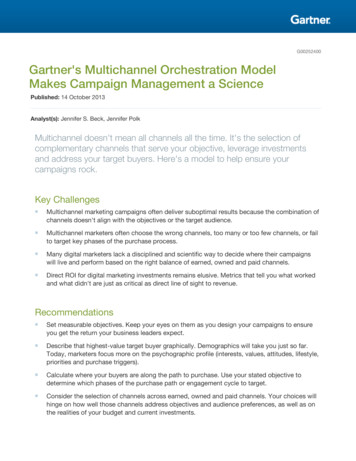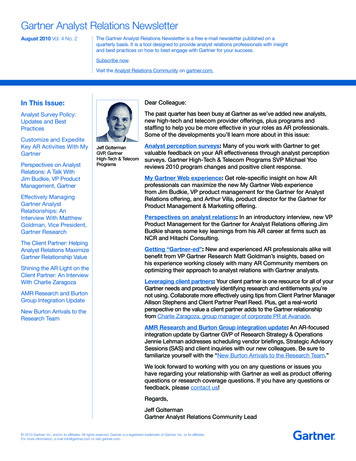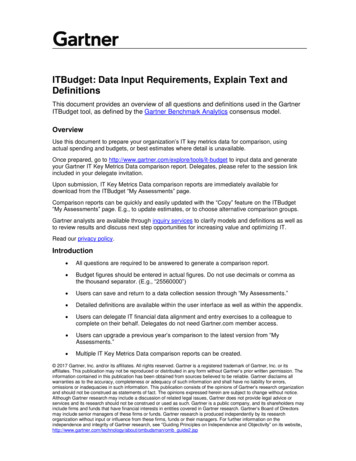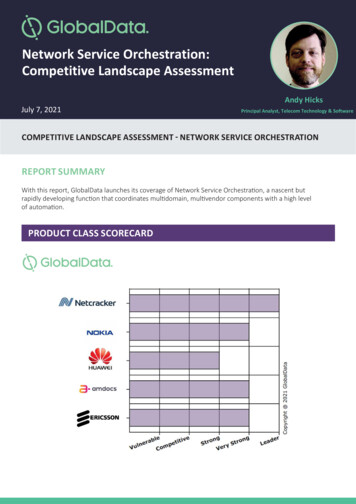
Transcription
G00252400Gartner's Multichannel Orchestration ModelMakes Campaign Management a SciencePublished: 14 October 2013Analyst(s): Jennifer S. Beck, Jennifer PolkMultichannel doesn't mean all channels all the time. It's the selection ofcomplementary channels that serve your objective, leverage investmentsand address your target buyers. Here's a model to help ensure yourcampaigns rock.Key Challenges Multichannel marketing campaigns often deliver suboptimal results because the combination ofchannels doesn't align with the objectives or the target audience. Multichannel marketers often choose the wrong channels, too many or too few channels, or failto target key phases of the purchase process. Many digital marketers lack a disciplined and scientific way to decide where their campaignswill live and perform based on the right balance of earned, owned and paid channels. Direct ROI for digital marketing investments remains elusive. Metrics that tell you what workedand what didn't are just as critical as direct line of sight to revenue.Recommendations Set measurable objectives. Keep your eyes on them as you design your campaigns to ensureyou get the return your business leaders expect. Describe that highest-value target buyer graphically. Demographics will take you just so far.Today, marketers focus more on the psychographic profile (interests, values, attitudes, lifestyle,priorities and purchase triggers). Calculate where your buyers are along the path to purchase. Use your stated objective todetermine which phases of the purchase path or engagement cycle to target. Consider the selection of channels across earned, owned and paid channels. Your choices willhinge on how well those channels address objectives and audience preferences, as well as onthe realities of your budget and current investments.
Define the metrics that indicate whether you have succeeded in driving customer behaviors thatlead to purchase. You can't manage what you don't measure.Table of ContentsIntroduction. 2Analysis. 4Step 1: Set Goals. 4Step 2: Profile Your Target Audience. 5Step 3: Identify the Organization's Constraints.5Step 4: Map the Channels You Will Use.6Consider Different Approaches in Support of Your Goal.6Step 5: Measure the Results.9Gartner Recommended Reading. 9List of FiguresFigure 1. Multichannel Orchestration Model. 3Figure 2. Our "Product". 4Figure 3. Multichannel Orchestration Matrix for Swan Campaign. 8IntroductionDigital marketers who plan a multichannel campaign continue to struggle with the question of whichchannels to use and how many (see Note 1). Marketers may choose channels because they're "hot"or because they happen to be easy to mobilize within the company or agency. They may addressthe audience at the wrong point in the buying process. Without deliberate planning that bringstogether objectives, a rich target profile and the optimal mix of channels, multichannel campaignshave a 50/50 chance of delivering the goods. You can optimize results by orchestratingmultichannel campaigns systematically if you follow a simple five-step process using Gartner'sorchestration model (see Figure 1). Over time, you can add to it and get more sophisticated in howyou execute multichannel initiatives. This model will help you with the science so you canconcentrate more on the art.Page 2 of 11Gartner, Inc. G00252400
Figure 1. Multichannel Orchestration ModelPurchase PathAwarenessIntentionDesireActionAdvocacyChannel ChoicesOwnedPaidEarnedSource: Gartner (October 2013)We'll use the example of selling giant inflatable pool swans to consumers and resorts to illustratehow the model works (see Figure 2).Gartner, Inc. G00252400Page 3 of 11
Figure 2. Our "Product"Source: Toy SplashAnalysisStep 1: Set GoalsEvery initiative starts here, but multichannel campaigns can quickly lose focus. The size orcomplexity of these campaigns leads to multiple objectives if you're not careful.In our example the goal is straightforward and measurable. You need to sell 20,000 units of a giant,inflatable pool swan by 1 January 2014. It's a new product, but also an extension of your poolaccessories line and on the pricey side. So you have a revenue target and a product — more oftenthan not, this is how the directive is articulated. Now you start the process of thinking through thecampaign. You realize this campaign isn't about awareness. You choose to move those fencesitters who love your dragon float, but the aggressive goals force you off the current buyer segmentand into new markets.What to Do NextIdentify the goal, for example: Cross-sell and upsell current customers Gain consideration with fence-sitters Identify and engage new customersPage 4 of 11Gartner, Inc. G00252400
Enter new market segmentsStep 2: Profile Your Target AudienceUse all the information you have available to create a psychographic profile of your best customers.You may start with demographic information (for instance, people of a certain age, gender andgeographic location), but you also need to understand channel preferences, price sensitivity andpropensity to advocate, and to zero in on the social or interest graph that best describes the idealtarget: Owns a pool or lives by a lake Weighs less than 250 pounds Is not price-sensitive Has no latex allergies Entertains often Drinks rum or beer Has previously purchased a sea dragon floatWhat to Do NextDo some data housekeeping. The information you collect about your target audience will come fromvarious sources inside and outside of your company. Much of the data will be out-of-date orincompatible. Therefore: Clean your contact database, integrate datasets, and remove duplications. Run tests to make sure the customer intelligence you have compiled yields accurate resultswhen queried.Step 3: Identify the Organization's ConstraintsNow, articulate a plan that holds up under management scrutiny and gives a road map to all theplayers: agencies, your marketing team, product management, distribution, the Web team,customer service Here, digital marketers start to introduce or avoid huge risk.You plan the pool swan campaign for one month. You'll involve your social marketing, website andemail marketing teams. Do they have the bandwidth to help? You need to touch base with yoursuppliers and distributors to make sure they can handle the volume. And what happens ifconsumers buy 30,000 floats instead of 20,000 — can you keep up with demand? You'll also needyour ad agency to help you buy leads and media time. Can they get your ad to the right people inthe right places at the right price?What to Do NextGartner, Inc. G00252400Page 5 of 11
Inventory your marketing assets and constraints: Can you reuse marketing material from aprevious product launch? Do you have product descriptions, videos and other content for thenew product? You don't get unlimited resources, so what is off limits? Maybe TV is tooexpensive. Maybe you don't have the skills to mount a social campaign Assess market dynamics: What is the primary selling feature? What market need does it fulfill?What competitor products exist, and what is the competition likely to do? Confirm field readiness: Can you deliver your product, to retailers or to Internet buyers? Canmanufacturing and inventory keep pace with sales? Is customer service aware and ready toanswer customer questions?Step 4: Map the Channels You Will UseThe key step is to fill out the matrix shown in Figure 1 above. Your goal (Step 1) will determinewhich phases of the purchase process your campaign needs to target (for example, the awarenessphase is important for extending your brand to new consumers, while the action phase matters forsales). Your target profile (Step 2) will show you which paid (for example, advertising and search);owned (websites, blogs and communities); and earned (through public relations or social networks)channels to use. It will also help you identify the necessary marketing assets, constraints, anddelivery and service requirements. For example, does the target audience for your pool swancampaign use mobile devices or surf the Web from home? Of the channels that suit your audience,which ones can you use most effectively? What will it take to do so?How do you fill out the orchestration model? When considering your approach to multichannel, startby asking: What does the purchase process look like for your target audience? What are the commonpurchase triggers? What channels does the audience use for research? Within which channels should you establish a presence in order to engage your audience? Canyou maintain an authentic brand presence in those channels? What are the key product attributes? Certain channels and tactics may suit particular attributes.If color is key, visual storytelling might illustrate the color variety in your product assortment. Where must your brand campaign be unique to differentiate it across each channel and versuscompetitors? How can you create seamless transitions across channels to deliver a cohesive and consistentcustomer experience? How do budget realities, public perception of your brand and results from prior campaignsshape your multichannel marketing efforts?Consider Different Approaches in Support of Your GoalThe answers to these questions will help you choose from one of the three approaches tomultichannel campaigns — which one best suits the pool swan campaign?Page 6 of 11Gartner, Inc. G00252400
Approach No. 1 — Single: Go long in one channel, with extension into other channels viatransmedia. The primary channel engages the audience while the secondary channels promote orexpand the campaign, if that's even necessary to achieve your sales goal. For example, MTVlaunched an eight-week search for a Twitter Jockey — a social media ambassador who will be paid 100,000 for one year. MTV executed the campaign on Twitter but used its website (owned), othersocial sites (earned) and local and national media coverage (earned) to promote participation.Choose this approach when: Budget constraints limit your choice. Desired engagement is channel-specific. Jello's Fun My Life campaign was based on a1commonly used Twitter hashtag — #FML — with limited applicability elsewhere. Campaign results can aid your business case for expansion into other channels.Approach No. 2 — Sequential: Build momentum by launching your marketing program insequences across multiple channels. P.F. Chang's ran a three-week promotional campaign onFacebook (paid and earned) to drive coupon downloads. After the campaign had reached 9.1million Facebook users, the brand used Facebook-sponsored stories (paid), its website (owned),email (owned) and media coverage (earned) to attract more attention. Choose this approach when: Sequencing across channels enables you to broaden the campaign narrative. For its L'Invitationau Voyage campaign, Louis Vuitton seeded teaser footage through social sites (earned), itswebsite (owned) and print ads (paid). After grabbing the audience's attention, the brand drewFacebook fans deeper into the storyline through social media content, including an invitation2only premier of a full TV ad through a Facebook application (earned and paid). Launching in phases across channels positions you to generate insights that can inform latercampaign elements. A Dove campaign started with mobile ads (paid) that asked women tosubmit photos of themselves with clean, healthy skin. The ads drove traffic to a branded mobilesite (owned) where women could upload photos, with the possibility of being chosen to appearin a Times Square billboard ad (paid). Dove built a library of user-generated content that it laterrepurposed on its website (owned), social sites (earned) and ads (paid).3Approach No. 3 — Simultaneous: Launch your campaign across several channels simultaneouslyto immerse the audience and create numerous opportunities for customer interaction. Massorchestration does not eliminate the need to identify your target audience. This approach willrequire substantial resources. Choose this approach when: You are launching a new brand or product or rebranding. Old Spice's "The Man Your ManShould Smell Like" campaign launched on YouTube during the Super Bowl (paid and earned),4generated buzz on social sites and prompted video responses from the brand (earned). Thebrand also invested in social advertising, such as a promoted Twitter trend (paid) to maximizecampaign visibility within specific channels. The campaign, which was featured on the OldSpice website (owned), also garnered national media coverage (earned).Gartner, Inc. G002524005Page 7 of 11
You are telling a big story that suits multiple channels because of the unique attributes of eachchannel. Cars.com's "All Drive. No Drama" campaign included TV ads (paid) during the SuperBowl to get media attention (earned) and prompt social chatter (earned). The brand alsoinvested in digital advertising (paid), which targeted specific audiences and drove traffic to aninteractive website (owned). Contests and content on social sites (earned) kept organic6conversation going.Probably the sequential approach would work best for the swan campaign. It focuses on movingfence-sitters (people who already know about the product) to want the new float and to buy it.Therefore, the campaign hits mainly the intention, desire and action phases (see Figure 3). Thebudget and target profile suggest an array of channels to use.Figure 3. Multichannel Orchestration Matrix for Swan CampaignPurchase PathAwarenessIntentionChannel ChoicesOwnedDesireActionAdvocacyXFacebookpage postEmail tocustomers,prospectsWebsiteenhancementto featureswan dealsXXGeotargetedpaid searchDisplay ad,retargeting,direct mailXXSocialpromotionSocial comarketing,social sharingencouragedby incentivesPaidEarnedXXRatings andreviews,Pinterest,TwitterSource: Gartner (October 2013)What to Do Next Define the consumer benefit. How is the consumer better off? Do they have the information tomake a purchase decision? Have you added dimension to the brand story? Plan the life cycle of the campaign. What is the life expectancy of the customer experience?What is the exit plan across the various channels? If you take the "single" approach, use the results to gain insight into what did or did not workand build a business case for greater investment in secondary channels.Page 8 of 11Gartner, Inc. G00252400
Step 5: Measure the ResultsLast, you have to understand and report on whether you achieved your goal (sell 20,000 units)within budget and within the campaign's time frame (end of the year) and understand whichchannels yielded business results. You will also benefit from finding out what works and whatdoesn't with each channel so that you can adjust the campaign while it's in progress and applythese lessons to future campaign designs.What to Do Next Define metrics upfront that tell you whether you have succeeded in customer engagement —for instance, satisfaction, recommendations and social sharing — as well as internal goals, suchas lead conversion rates.Gartner Recommended ReadingSome documents may not be available as part of your current Gartner subscription. "Five Things Your Executives Need to Know About Going Digital" "Use This Framework for Multichannel Campaign Management" "Cost Optimization in Multichannel Marketing" "Marketers Look to the Zero Moment of Truth Framework for Digital Commerce Planning"EvidenceWe based this report on discussions with digital marketers designing multichannel campaigns andon our own agency and digital marketing strategy experience working on them as recentpractitioners. Internal Gartner research discussion helped us to formulate the orchestration modeland process.1 H.Bradford, "Jell-O's Fun My Life Twitter Campaign: Social Media Genius or Just 'Funning'Annoying?" Huffington Post, 24 May 2013.2 T.Carr, "Louis Vuitton Eyes the Masses With First TV Commercial," Luxury Daily, 12 November2012.3 L.Johnson, "Unilever's Dove Promotes Beauty Products Through Multichannel Digital Effort,"Mobile Marketer, 1 May 2012.4 C.Hodgson, "Old Spice — Brand Reborn by Hunk on a Horse," Brandaide.5 E.Boches, "'The Man Your Man Could Smell Like' Responds to the Internet," Effie Awards, 27October 2011.Gartner, Inc. G00252400Page 9 of 11
6 "Cars.comRevs Up the Drama in Its Latest Commercial With a Cameo From Actor James Van DerBeek," PR Newswire, 6 June 2013.Note 1 Definition of Multichannel MarketingGartner defines multichannel marketing as optimizing the customer engagement according to theway customers want to talk, shop, buy and obtain services through digital and offline channels,orchestrated to build ensemble interactions that create differentiated and compelling experiences.Page 10 of 11Gartner, Inc. G00252400
GARTNER HEADQUARTERSCorporate Headquarters56 Top Gallant RoadStamford, CT 06902-7700USA 1 203 964 0096Regional HeadquartersAUSTRALIABRAZILJAPANUNITED KINGDOMFor a complete list of worldwide locations,visit http://www.gartner.com/technology/about.jsp 2013 Gartner, Inc. and/or its affiliates. All rights reserved. Gartner is a registered trademark of Gartner, Inc. or its affiliates. Thispublication may not be reproduced or distributed in any form without Gartner’s prior written permission. If you are authorized to accessthis publication, your use of it is subject to the Usage Guidelines for Gartner Services posted on gartner.com. The information containedin this publication has been obtained from sources believed to be reliable. Gartner disclaims all warranties as to the accuracy,completeness or adequacy of such information and shall have no liability for errors, omissions or inadequacies in such information. Thispublication consists of the opinions of Gartner’s research organization and should not be construed as statements of fact. The opinionsexpressed herein are subject to change without notice. Although Gartner research may include a discussion of related legal issues,Gartner does not provide legal advice or services and its research should not be construed or used as such. Gartner is a public company,and its shareholders may include firms and funds that have financial interests in entities covered in Gartner research. Gartner’s Board ofDirectors may include senior managers of these firms or funds. Gartner research is produced independently by its research organizationwithout input or influence from these firms, funds or their managers. For further information on the independence and integrity of Gartnerresearch, see “Guiding Principles on Independence and Objectivity.”Gartner, Inc. G00252400Page 11 of 11
Multichannel doesn't mean all channels all the time. It's the selection of complementary channels that serve your objective, leverage investments and address your target buyers. Here's a model to help ensure your campaigns rock. Key Challenges Multichannel marketing campaigns often deliver suboptimal results because the combination of










